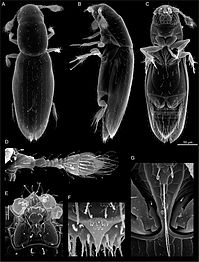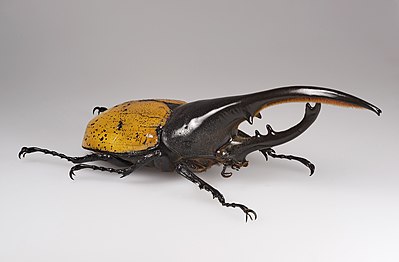Beetle
| Beetle | |
|---|---|

| |
| Clockwise from top left: female golden stag beetle ( Rhinotia hemistictus), cowboy beetle (Chondropyga dorsalis), and a species of Amblytelus
| |
| Scientific classification | |
| Domain: | Eukaryota |
| Kingdom: | Animalia |
| Phylum: | Arthropoda |
| Class: | Insecta |
| Clade: | Coleopterida |
| Order: | Coleoptera Linnaeus, 1758 |
Suborders[1]
| |
Beetles are
Beetles typically have a particularly hard
Beetles are prominent
Etymology
The name of the taxonomic order, Coleoptera, comes from the Greek koleopteros (κολεόπτερος), given to the group by Aristotle for their elytra, hardened shield-like forewings, from koleos, sheath, and pteron, wing. The English name beetle comes from the Old English word bitela, little biter, related to bītan (to bite),[3][4] leading to Middle English betylle.[5] Another Old English name for beetle is ċeafor, chafer, used in names such as cockchafer, from the Proto-Germanic *kebrô ("beetle"; compare German Käfer, Dutch kever, Afrikaans kewer).[6]
Distribution and diversity
Beetles are by far the largest order of insects: the roughly 400,000 species make up about 40% of all insect species so far described, and about 25% of all animal species.[1][7][8][9][10][11] A 2015 study provided four independent estimates of the total number of beetle species, giving a mean estimate of some 1.5 million with a "surprisingly narrow range"[12] spanning all four estimates from a minimum of 0.9 to a maximum of 2.1 million beetle species. The four estimates made use of host-specificity relationships (1.5 to 1.9 million), ratios with other taxa (0.9 to 1.2 million), plant:beetle ratios (1.2 to 1.3), and extrapolations based on body size by year of description (1.7 to 2.1 million).[12][13]
This immense diversity led the evolutionary biologist
However, the ranking of beetles as most diverse has been challenged. Multiple studies posit that Diptera (flies) and/or Hymenoptera (sawflies, wasps, ants and bees) may have more species.[15][16][17]
Beetles are found in nearly all habitats, including freshwater and coastal habitats, wherever vegetative foliage is found, from trees and their bark to flowers, leaves, and underground near roots - even inside plants in galls, in every plant tissue, including dead or decaying ones.[18] Tropical forest canopies have a large and diverse fauna of beetles,[19] including Carabidae,[20] Chrysomelidae,[21] and Scarabaeidae.[22]
The heaviest beetle, indeed the heaviest insect stage, is the
The longest beetle is the
-
Titan beetle, Titanus giganteus, a tropical longhorn, is one of the largest and heaviest insects in the world.
-
Scydosella musawasensis, the smallest known beetle: scale bar (right) is 50 μm.
-
Hercules beetle, Dynastes hercules ecuatorianus, the longest of all beetles.
-
Iridescent Protaetia cuprea feeding on thistle.
Evolution
Late Paleozoic and Triassic

The oldest known beetle is
Jurassic
There are more than 150 important fossil sites from the Jurassic, the majority in Eastern Europe and North Asia. Outstanding sites include Solnhofen in Upper Bavaria, Germany,[37] Karatau in South Kazakhstan,[38] the Yixian formation in Liaoning, North China,[39] as well as the Jiulongshan formation and further fossil sites in Mongolia. In North America there are only a few sites with fossil records of insects from the Jurassic, namely the shell limestone deposits in the Hartford basin, the Deerfield basin and the Newark basin.[29][40]
Cretaceous
The
Many fossil sites worldwide contain beetles from the Cretaceous. Most are in Europe and Asia and belong to the temperate climate zone during the Cretaceous.
Cenozoic
Beetle fossils are abundant in the Cenozoic; by the Quaternary (up to 1.6 mya), fossil species are identical to living ones, while from the Late Miocene (5.7 mya) the fossils are still so close to modern forms that they are most likely the ancestors of living species. The large oscillations in climate during the Quaternary caused beetles to change their geographic distributions so much that current location gives little clue to the biogeographical history of a species. It is evident that geographic isolation of populations must often have been broken as insects moved under the influence of changing climate, causing mixing of gene pools, rapid evolution, and extinctions, especially in middle latitudes.[46]
Phylogeny
The very large number of beetle species poses special problems for classification. Some families contain tens of thousands of species, and need to be divided into subfamilies and tribes. Polyphaga is the largest suborder, containing more than 300,000 described species in more than 170 families, including rove beetles (Staphylinidae), scarab beetles (Scarabaeidae), blister beetles (Meloidae), stag beetles (Lucanidae) and true weevils (Curculionidae).[10][47] These polyphagan beetle groups can be identified by the presence of cervical sclerites (hardened parts of the head used as points of attachment for muscles) absent in the other suborders.[48]
The consistency of beetle
Molecular phylogenetic analysis confirms that the Coleoptera are monophyletic. Duane McKenna et al. (2015) used eight nuclear genes for 367 species from 172 of 183 Coleopteran families. They split the Adephaga into 2 clades, Hydradephaga and Geadephaga, broke up the Cucujoidea into 3 clades, and placed the Lymexyloidea within the Tenebrionoidea. The Polyphaga appear to date from the Triassic. Most extant beetle families appear to have arisen in the Cretaceous.[60] The cladogram is based on McKenna (2015).[60] The number of species in each group (mainly superfamilies) is shown in parentheses, and boldface if over 10,000.[61] English common names are given where possible. Dates of origin of major groups are shown in italics in millions of years ago (mya).[61]
| Coleoptera |
| |||||||||||||||||||||||||||||||||||||||||||||||||||||||||||||||||||||||||||||||||||||||||||||||||||||||||||||||||||||
| 285 mya |
External morphology
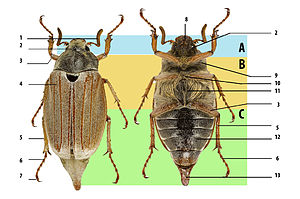
Beetles are generally characterized by a particularly hard exoskeleton and hard forewings (elytra) not usable for flying. Almost all beetles have mandibles that move in a horizontal plane. The mouthparts are rarely suctorial, though they are sometimes reduced; the maxillae always bear palps. The antennae usually have 11 or fewer segments, except in some groups like the Cerambycidae (longhorn beetles) and the Rhipiceridae (cicada parasite beetles). The coxae of the legs are usually located recessed within a coxal cavity. The genitalic structures are telescoped into the last abdominal segment in all extant beetles. Beetle larvae can often be confused with those of other holometabolan groups.[51] The beetle's exoskeleton is made up of numerous plates, called sclerites, separated by thin sutures. This design provides armored defenses while maintaining flexibility. The general anatomy of a beetle is quite uniform, although specific organs and appendages vary greatly in appearance and function between the many families in the order. Like all insects, beetles' bodies are divided into three sections: the head, the thorax, and the abdomen.[8] Because there are so many species, identification is quite difficult, and relies on attributes including the shape of the antennae, the tarsal formulae[a] and shapes of these small segments on the legs, the mouthparts, and the ventral plates (sterna, pleura, coxae). In many species accurate identification can only be made by examination of the unique male genitalic structures.[62]
Head
The head, having mouthparts projecting forward or sometimes downturned, is usually heavily

Beetle antennae are primarily organs of sensory perception and can detect motion, odor and chemical substances,[66] but may also be used to physically feel a beetle's environment. Beetle families may use antennae in different ways. For example, when moving quickly, tiger beetles may not be able to see very well and instead hold their antennae rigidly in front of them in order to avoid obstacles.[67] Certain Cerambycidae use antennae to balance, and blister beetles may use them for grasping. Some aquatic beetle species may use antennae for gathering air and passing it under the body whilst submerged. Equally, some families use antennae during mating, and a few species use them for defense. In the cerambycid Onychocerus albitarsis, the antennae have venom injecting structures used in defense, which is unique among arthropods.[68] Antennae vary greatly in form, sometimes between the sexes, but are often similar within any given family. Antennae may be clubbed, threadlike, angled, shaped like a string of beads, comb-like (either on one side or both, bipectinate), or toothed. The physical variation of antennae is important for the identification of many beetle groups. The Curculionidae have elbowed or geniculate antennae. Feather like flabellate antennae are a restricted form found in the Rhipiceridae and a few other families. The Silphidae have a capitate antennae with a spherical head at the tip. The Scarabaeidae typically have lamellate antennae with the terminal segments extended into long flat structures stacked together. The Carabidae typically have thread-like antennae. The antennae arises between the eye and the mandibles and in the Tenebrionidae, the antennae rise in front of a notch that breaks the usually circular outline of the compound eye. They are segmented and usually consist of 11 parts, the first part is called the scape and the second part is the pedicel. The other segments are jointly called the flagellum.[66][69][70]
Beetles have
Thorax
The thorax is

Legs
The multisegmented
Wings

The forewings of beetles are not used for
Beetles' flight wings are crossed with veins and are folded after landing, often along these veins, and stored below the elytra. A fold (jugum) of the membrane at the base of each wing is characteristic.
Abdomen
The abdomen is the section behind the metathorax, made up of a series of rings, each with a hole for breathing and respiration, called a spiracle, composing three different segmented sclerites: the tergum, pleura, and the sternum. The tergum in almost all species is membranous, or usually soft and concealed by the wings and elytra when not in flight. The pleura are usually small or hidden in some species, with each pleuron having a single spiracle. The sternum is the most widely visible part of the abdomen, being a more or less sclerotized segment. The abdomen itself does not have any appendages, but some (for example, Mordellidae) have articulating sternal lobes.[78]
Anatomy and physiology
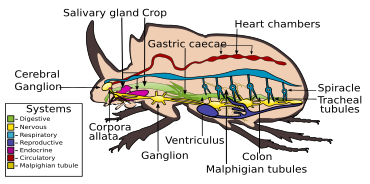
Digestive system
The
Nervous system
The nervous system in beetles contains all the types found in insects, varying between different species, from three thoracic and seven or eight abdominal ganglia which can be distinguished to that in which all the thoracic and abdominal ganglia are fused to form a composite structure.[8]
Respiratory system
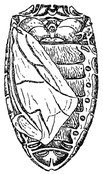
Like most insects, beetles inhale air, for the
Diving beetles, such as the Dytiscidae, carry a bubble of air with them when they dive. Such a bubble may be contained under the elytra or against the body by specialized hydrophobic hairs. The bubble covers at least some of the spiracles, permitting air to enter the tracheae.[8] The function of the bubble is not only to contain a store of air but to act as a physical gill. The air that it traps is in contact with oxygenated water, so as the animal's consumption depletes the oxygen in the bubble, more oxygen can diffuse in to replenish it.[79] Carbon dioxide is more soluble in water than either oxygen or nitrogen, so it readily diffuses out faster than in. Nitrogen is the most plentiful gas in the bubble, and the least soluble, so it constitutes a relatively static component of the bubble and acts as a stable medium for respiratory gases to accumulate in and pass through. Occasional visits to the surface are sufficient for the beetle to re-establish the constitution of the bubble.[80]
Circulatory system
Like other insects, beetles have
Specialized organs
Different glands are specialized for different pheromones to attract mates. Pheromones from species of
Tympanal organs or hearing organs consist of a membrane (tympanum) stretched across a frame backed by an air sac and associated sensory neurons, are found in two families.[82] Several species of the genus Cicindela (Carabidae) have hearing organs on the dorsal surfaces of their first abdominal segments beneath the wings; two tribes in the Dynastinae (within the Scarabaeidae) have hearing organs just beneath their pronotal shields or neck membranes. Both families are sensitive to ultrasonic frequencies, with strong evidence indicating they function to detect the presence of bats by their ultrasonic echolocation.[8]
Reproduction and development
Beetles are members of the
Mating

Some beetles have intricate mating behaviour. Pheromone communication is often important in locating a mate. Different species use different pheromones. Scarab beetles such as the Rutelinae use pheromones derived from fatty acid synthesis, while other scarabs such as the Melolonthinae use amino acids and terpenoids. Another way beetles find mates is seen in the fireflies (Lampyridae) which are bioluminescent, with abdominal light-producing organs. The males and females engage in a complex dialog before mating; each species has a unique combination of flight patterns, duration, composition, and intensity of the light produced.[8]
Before mating, males and females may stridulate, or vibrate the objects they are on. In the Meloidae, the male climbs onto the dorsum of the female and strokes his antennae on her head, palps, and antennae. In
Life cycle

Egg
Essentially all beetles lay eggs, though some
Larva
The

Beetle larvae can be differentiated from other insect larvae by their hardened, often darkened heads, the presence of chewing mouthparts, and spiracles along the sides of their bodies. Like adult beetles, the larvae are varied in appearance, particularly between beetle families. Beetles with somewhat flattened, highly mobile larvae include the ground beetles and rove beetles; their larvae are described as campodeiform. Some beetle larvae resemble hardened worms with dark head capsules and minute legs. These are elateriform larvae, and are found in the click beetle (Elateridae) and darkling beetle (Tenebrionidae) families. Some elateriform larvae of click beetles are known as wireworms. Beetles in the Scarabaeoidea have short, thick larvae described as scarabaeiform, more commonly known as grubs.[88]
All beetle larvae go through several
The larval period can vary widely. A fungus feeding staphylinid Phanerota fasciata undergoes three moults in 3.2 days at room temperature while Anisotoma sp. (Leiodidae) completes its larval stage in the fruiting body of slime mold in 2 days and possibly represents the fastest growing beetles. Dermestid beetles, Trogoderma inclusum can remain in an extended larval state under unfavourable conditions, even reducing their size between moults. A larva is reported to have survived for 3.5 years in an enclosed container.[8]
Pupa and adult
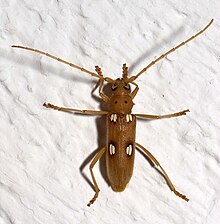
As with all holometabolans, beetle larvae pupate, and from these
Adults have extremely variable lifespans, from weeks to years, depending on the species.
Behaviour
Locomotion

The elytra allow beetles to both fly and move through confined spaces, doing so by folding the delicate wings under the elytra while not flying, and folding their wings out just before takeoff. The unfolding and folding of the wings is operated by muscles attached to the wing base; as long as the tension on the radial and cubital veins remains, the wings remain straight.[8] Some beetle species (many Cetoniinae; some Scarabaeinae, Curculionidae and Buprestidae) fly with the elytra closed, with the metathoracic wings extended under the lateral elytra margins.[92] The altitude reached by beetles in flight varies. One study investigating the flight altitude of the ladybird species Coccinella septempunctata and Harmonia axyridis using radar showed that, whilst the majority in flight over a single location were at 150–195 m above ground level, some reached altitudes of over 1100 m.[93]
Many rove beetles have greatly reduced elytra, and while they are capable of flight, they most often move on the ground: their soft bodies and strong abdominal muscles make them flexible, easily able to wriggle into small cracks.[94]
Aquatic beetles use several techniques for retaining air beneath the water's surface. Diving beetles (Dytiscidae) hold air between the abdomen and the elytra when diving. Hydrophilidae have hairs on their under surface that retain a layer of air against their bodies. Adult crawling water beetles use both their elytra and their hind coxae (the basal segment of the back legs) in air retention, while whirligig beetles simply carry an air bubble down with them whenever they dive.[95]
Communication
Beetles have a variety of ways to communicate, including the use of
Parental care

Parental care is found in a few families
Burying beetles are attentive parents, and participate in cooperative care and feeding of their offspring. Both parents work to bury small animal carcass to serve as a food resource for their young and build a brood chamber around it. The parents prepare the carcass and protect it from competitors and from early decomposition. After their eggs hatch, the parents keep the larvae clean of fungus and bacteria and help the larvae feed by regurgitating food for them.[100]
Some dung beetles provide parental care, collecting herbivore dung and laying eggs within that food supply, an instance of mass provisioning. Some species do not leave after this stage, but remain to safeguard their offspring.[101]
Most species of beetles do not display parental care behaviors after the eggs have been laid.[102]
Subsociality, where females guard their offspring, is well-documented in two families of Chrysomelidae, Cassidinae and Chrysomelinae.[103][104][105][106][107]
Eusociality
Eusociality involves cooperative brood care (including brood care of offspring from other individuals), overlapping generations within a colony of adults, and a division of labor into reproductive and non-reproductive groups.[108] Few organisms outside Hymenoptera exhibit this behavior; the only beetle to do so is the weevil Austroplatypus incompertus.[109] This Australian species lives in horizontal networks of tunnels, in the heartwood of Eucalyptus trees. It is one of more than 300 species of wood-boring Ambrosia beetles which distribute the spores of ambrosia fungi.[110] The fungi grow in the beetles' tunnels, providing food for the beetles and their larvae; female offspring remain in the tunnels and maintain the fungal growth, probably never reproducing.[110][109] Cooperative brood care is also found in the bess beetles (Passalidae) where the larvae feed on the semi-digested faeces of the adults.[111]
Feeding

Beetles are able to exploit a wide diversity of food sources available in their many habitats. Some are
Decaying organic matter is a primary diet for many species. This can range from
Ecology

Anti-predator adaptations
Beetles, both adults and larvae, are the prey of many animal
Camouflage
Camouflage is common and widespread among beetle families, especially those that feed on wood or vegetation, such as leaf beetles (Chrysomelidae, which are often green) and weevils. In some species, sculpturing or various colored scales or hairs cause beetles such as the avocado weevil Heilipus apiatus to resemble bird dung or other inedible objects.[116] Many beetles that live in sandy environments blend in with the coloration of that substrate.[118]
Mimicry and aposematism

Some
Chemical defense is important in some species, usually being advertised by bright aposematic colors. Some
Other species have special glands to produce deterrent chemicals. The defensive glands of carabid ground beetles produce a variety of hydrocarbons, aldehydes, phenols, quinones, esters, and acids released from an opening at the end of the abdomen. African carabid beetles (for example, Anthia) employ the same chemicals as ants: formic acid.[119] Bombardier beetles have well-developed pygidial glands that empty from the sides of the intersegment membranes between the seventh and eighth abdominal segments. The gland is made of two containing chambers, one for hydroquinones and hydrogen peroxide, the other holding hydrogen peroxide and catalase enzymes. These chemicals mix and result in an explosive ejection, reaching a temperature of around 100 °C (212 °F), with the breakdown of hydroquinone to hydrogen, oxygen, and quinone. The oxygen propels the noxious chemical spray as a jet that can be aimed accurately at predators.[8]
Other defenses
Large ground-dwelling beetles such as
Parasitism
A few species of beetles are
Pollination

Beetle-pollinated flowers are usually large, greenish or off-white in color, and heavily scented. Scents may be spicy, fruity, or similar to decaying organic material. Beetles were most likely the first insects to pollinate flowers.
Mutualism
2: Larva feeds on fungus, which digests wood, removing toxins, to mutual benefit.
3: Larva pupates.

Tolerance of extreme environments
About 90% of beetle species enter a period of adult
All insects are
Conversely, desert dwelling beetles are adapted to tolerate high temperatures. For example, the
The fogstand beetle of the
Some terrestrial beetles that exploit shoreline and floodplain habitats have physiological adaptations for surviving floods. In the event of flooding, adult beetles may be mobile enough to move away from flooding, but larvae and pupa often cannot. Adults of
Migration
Many beetle species undertake annual mass movements which are termed as migrations. These include the pollen beetle
Relationship to humans
In ancient cultures
| ||
| Scarabee in hieroglyphs | ||
|---|---|---|
| Gardiner: L1 | ||

Several species of dung beetle, especially the sacred scarab,
As pests
About 75% of beetle species are phytophagous in both the larval and adult stages. Many feed on economically important plants and stored plant products, including trees, cereals, tobacco, and dried fruits.[7] Some, such as the boll weevil, which feeds on cotton buds and flowers, can cause extremely serious damage to agriculture. The boll weevil crossed the Rio Grande near Brownsville, Texas, to enter the United States from Mexico around 1892,[161] and had reached southeastern Alabama by 1915. By the mid-1920s, it had entered all cotton-growing regions in the US, traveling 40 to 160 miles (60–260 km) per year. It remains the most destructive cotton pest in North America. Mississippi State University has estimated, since the boll weevil entered the United States, it has cost cotton producers about $13 billion, and in recent times about $300 million per year.[161]
The

Some species of beetle have evolved immunity to insecticides. For example, the
The
Other pests include the coconut hispine beetle,
As beneficial resources

Beetles can be beneficial to human economics by controlling the populations of pests. The larvae and adults of some species of
The Dermestidae are often used in taxidermy and in the preparation of scientific specimens, to clean soft tissue from bones.[179] Larvae feed on and remove cartilage along with other soft tissue.[180][181]
As food and medicine
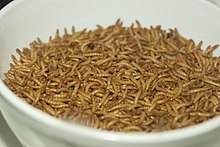
Beetles are the most widely eaten insects, with about 344 species used as food, usually at the larval stage.
As biodiversity indicators
Due to their habitat specificity, many species of beetles have been suggested as suitable as indicators, their presence, numbers, or absence providing a measure of habitat quality. Predatory beetles such as the tiger beetles (
In art and adornment
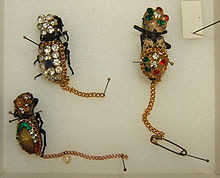

Many beetles have durable elytra that has been used as material in art, with
In entertainment
Fighting beetles are used for entertainment and gambling. This sport exploits the territorial behavior and mating competition of certain species of large beetles. In the Chiang Mai district of northern Thailand, male Xylotrupes rhinoceros beetles are caught in the wild and trained for fighting. Females are held inside a log to stimulate the fighting males with their pheromones.[191] These fights may be competitive and involve gambling both money and property.[192] In South Korea the Dytiscidae species Cybister tripunctatus is used in a roulette-like game.[193]
Beetles are sometimes used as instruments: the Onabasulu of Papua New Guinea historically used the "hugu" weevil Rhynchophorus ferrugineus as a musical instrument by letting the human mouth serve as a variable resonance chamber for the wing vibrations of the live adult beetle.[192]
As pets
Some species of beetle are kept as pets, for example diving beetles (Dytiscidae) may be kept in a domestic fresh water tank.[194]
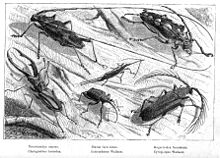
In
As things to collect
Beetle collecting became extremely popular in the Victorian era.[198] The naturalist Alfred Russel Wallace collected (by his own count) a total of 83,200 beetles during the eight years described in his 1869 book The Malay Archipelago, including 2,000 species new to science.[199]
As inspiration for technologies
Several coleopteran adaptations have attracted interest in
Living beetles have been used as
Research published in 2020 sought to create a robotic camera backpack for beetles. Miniature cameras weighing 248 mg were attached to live beetles of the
In conservation
Since beetles form such a large part of the world's biodiversity, their conservation is important, and equally, loss of habitat and biodiversity is essentially certain to impact on beetles. Many species of beetles have very specific habitats and long life cycles that make them vulnerable. Some species are highly threatened while others are already feared extinct.
Notes
References
- ^ PMID 21594053.
- S2CID 23755007.
- ^ Harper, Douglas. "Coleoptera". Online Etymology Dictionary.
- ^ Harper, Douglas. "Beetle". Online Etymology Dictionary.
- ^ "Beetle". Merriam-Webster Online Dictionary. Retrieved February 20, 2016.
- ^ Harper, Douglas. "Chafer". Online Etymology Dictionary.
- ^ ISBN 978-0-306-44967-3.
- ^ a b c d e f g h i j k l m n o p q McHugh (2009)
- ISBN 978-0-521-49952-1.
- ^ S2CID 19392955.
- )
- ^ PMID 26034274.
- ISBN 978-1-4443-3036-6.
- S2CID 26401739.
- PMID 27481785.
- S2CID 13819313.
- PMID 30001194.
- ISBN 978-1-4443-3036-6.
- ^ Kirmse S, Adis J, Morawetz W. 2003. Flowering events and beetle diversity in Venezuela. In: Basset Y, Novotny V, Miller SE, Kitching RL, editors. Arthropods of tropical forests: Spatio-temporal dynamics and resource use in the canopy. Cambridge: Cambridge University Press; p. 256–265.
- S2CID 52065045.
- S2CID 91732501.
- S2CID 108786139.
- ^ "Heaviest insect". Guinness World Records. Retrieved February 1, 2017.
- ^ Williams, David M. (2001). "Chapter 30 — Largest Insect". Book of Insect Records. University of Florida. Archived from the original on July 18, 2011.
- PMID 26487824.
- S2CID 85163674.
- ^ Hörnschemeyer, T.; Stapf, H. "Die Insektentaphozönose von Niedermoschel (Asselian, unt. Perm; Deutschland)". Schriften der Alfred-Wegener-Stiftung (in German) (99/8): 98.
- ^ Kukalová, J. (1969). "On the systematic position of the supposed Permian beetles, Tshecardocoleidae, with a description of a new collection from Moravia". Sborník Geologických Věd, Paleontologie. 11: 139–161.
- ^ a b c d e f Benisch, Christoph (2010). "Phylogeny of the beetles". The beetle fauna of Germany. Kerbtier. Retrieved March 16, 2011.
- S2CID 86835593. Archived from the original(PDF) on July 18, 2011.
- PMID 34747694.
- ^ a b c McHugh (2009), p. 186
- PMID 11536548. Archived from the original(PDF) on March 31, 2012.
- PMID 11536548. Archived from the original(PDF) on December 29, 2016. Retrieved March 16, 2011.
- doi:10.11646/zootaxa.1785.1.3. Archived from the original(PDF) on July 4, 2011.
- ^ Alexeev, A. V. (1993). "Jurassic and Lower Cretaceous Buprestidae (Coleoptera) from Eurasia" (PDF). Paleontological Journal (1A): 9–34. Archived (PDF) from the original on March 26, 2010.
- ^ Ponomarenko, Alexandr G. (1985). "Fossil insects from the Tithonian 'Solnhofener Plattenkalke' in the Museum of Natural History, Vienna" (PDF). Annalen des Naturhistorischen Museums in Wien. 87 (1): 135–144. Archived (PDF) from the original on July 4, 2011.
- S2CID 84621777. Archived from the original(PDF) on July 18, 2011.
- ^ S2CID 83733980. Archived from the original(PDF) on July 18, 2011.
- ^ Ponomarenko, A. G. (1997). "New beetles of the family Cupedidae from the Mesozoic of Mongolia. Ommatini, Mesocupedini, Priacmini" (PDF). Paleontological Journal. 31 (4): 389–399. Archived from the original (PDF) on September 25, 2006.
- S2CID 129618839. Archived from the original(PDF) on July 18, 2011.
- JSTOR 3515235.
- S2CID 83643794.
- .
- PMID 21957131.
- JSTOR 2096792.
- ^ Maddison, D. R. (1995). "Polyphaga". Tree of Life web project. Retrieved February 27, 2016.
- ISBN 978-3-11-017130-3.
- ISBN 978-3-11-017130-3.
- ^ "Suborder Archostemata – Reticulated and Telephone-pole Beetles". BugGuide. 2006. Retrieved January 26, 2017.
- ^ ISBN 978-0-643-09728-5.
- .
- ^ Beutel, Rolf G.; Leschen, Richard (2005). Handbook of Zoology. Volume 4. Part 38. Arthropoda. Morphology and Systematics (Archostemata, Adephaga, Myxophaga, Polyphaga partim). Walter de Gruyter. p. 43.
- S2CID 45544978.
- S2CID 56131113.
- ^ S2CID 52888506.
- PMID 19789725.
- ^ Maddison, David R. (September 11, 2000). "Coleoptera. Beetle". Tree of Life Web Project. tolweb.org. Retrieved March 18, 2011.
- PMID 22704986.
- ^ hdl:10057/11540.
- ^ S2CID 19392955.
- ^ "Introduction to the Identification of Beetles (Coleoptera)" (PDF). University of Florida. Retrieved March 15, 2017.
- .
- ^ ISBN 978-0-643-09487-1.
- ^ Gokan N.; Meyer-Rochow V.B. (2000). "Morphological comparisons of compound eyes in Scarabaeoidea (Coleoptera) related to the beetles' daily activity maxima and phylogenetic positions". Journal of Agricultural Science (Tokyo Nogyo Daigaku). 45 (1): 15–61.
- ^ a b Benisch, Christoph (2007). "3. Antennae, Beetle morphology". Kerbtier.de (Beetle fauna of Germany). Retrieved March 14, 2017.
- PMID 24500171.
- S2CID 30226487.
- ^ "Antennae Types". University of Sydney. Archived from the original on February 22, 2018. Retrieved January 26, 2017.
- ISBN 978-1-4822-7432-5.
- PMID 23825114.
- University of Minnesota Extension. Retrieved January 26, 2017.
- ^ a b Carpenter, George Herbert (1899). Insects, their structure and life.
- ^ Philips, Chris; Fread, Elizabeth; Kuhar, Tom, Leatherwing (Soldier) Beetles (PDF), archived from the original (PDF) on November 30, 2016, retrieved March 14, 2017
- ^ Donald W. Hall; Marc A. Branham (2016). "Calopteron discrepans (Newman) (Insecta: Coleoptera: Lycidae)". University of Florida. Retrieved March 15, 2017.
- ^ Lawrence, J. F.; Hastings, A. M.; Dallwitz, M. J.; Paine, T. A.; Zurcher, E. J. (2005). "Elateriformia (Coleoptera): descriptions, illustrations, identification, and information retrieval for families and subfamilies". Retrieved January 26, 2017.
- ^ Beenen, R; Winkelman, J. K. (2001). "Aantekeningen over Chrysomelidae in Nederland 5". Entomologische Berichten (in Dutch). 61: 63–67.
- ISBN 978-1-4822-7432-5.
- PMID 23255190.
- ISBN 978-0-521-57098-5.
- ISBN 978-0-08-030804-3.
- ISBN 978-1-4020-6242-1.
- ^ Spring BooksScience. pp. 30–32.
- ^ Ozbek, H.; Szalokia, D. (1998). "A contribution to the knowledge of the Meloidae (Coleoptera) fauna of Turkey along with new record". Turkish Journal of Zoology. 22: 23–40.
- ^ Medvedev, L. N.; Pavlov, S. I. (1988). "Mating behavior of the Chrysomelidae (Coleoptera)". Entomological Review. 67: 100–108.
- ISBN 978-1-4832-1760-4.
- S2CID 34101370.
- ^ "Definition of 'Scarabaeiform'". Amateur Entomologists' Society. Retrieved January 27, 2017.
- ISBN 978-0-12-372500-4.
- ^ "Hypermetamorphosis of Striped Blister Beetle – Epicauta vittata". BugGuide. 2007. Retrieved January 27, 2017.
- ^ Zeng, Yong (1995). "Longest Life Cycle". University of Florida. Retrieved March 17, 2017.
- PMID 27165937.
- PMID 24367512.
- ISBN 978-1-4020-6242-1.
- ISBN 978-0-8493-1925-9.
- ^ "Mountain Pine Beetle – Beetle Love". Parks Canada. Retrieved March 13, 2011.
- ^ a b Meyer-Rochow, V.B. (1971). "Observations on stridulating Australian beetles (Hydrophilidae, Cerambycidae, Passalidae, Dynastinae) using scanning electron microscopical and electrophysiological techniques". Forma et Functio. 4: 326–339.
- ^ Brandmayr P. 1992. Short review of the presocial evolution in Coleoptera. Ethol Ecol Evol. 4:7–16.
- JSTOR 4534785.
- JSTOR 25005075.
- ISBN 978-0-691-08739-9.
- ^ "Beetle | San Diego Zoo Animals & Plants". animals.sandiegozoo.org. Retrieved July 18, 2017.
- S2CID 84683405.
- S2CID 85885981.
- .
- S2CID 84744056.
- ^ Windsor DM, Choe JC. 1994. Origins of parental care in chrysomelid beetles. In: Jolivet PH, Cox ML, Petitipierre E, editors. Novel aspects of the biology of Chrysomelidae. Series Entomologica 50. Dordrecht: Kluwer Academic Publishers; p. 111–117.
- .
- ^ S2CID 35534268.
- ^ a b "Science: The Australian beetle that behaves like a bee". New Scientist. May 9, 1992. Retrieved October 31, 2010.
- JSTOR 3494359. Archived from the originalon March 2, 2016. Retrieved March 17, 2017.
- ^ Lobanov, A.L. (2002). "feeding". Beetle Biology And Ecology. Beetles (Coleoptera) and Coleopterologist. Retrieved March 13, 2011.
- ISBN 978-0-9863996-0-2.
- .
- S2CID 84593757.
- ^ a b c Evans & Bellamy (2000), pp. 27–28
- ^ Cott, H. B. (1940). Adaptive Coloration in Animals. Methuen. p. 414.
- ^ a b c Evans & Bellamy (2000), p. 126
- ^ a b Evans & Bellamy (2000)
- ^ McHugh (2009), p. 199
- ^ Peck, Stewart B. (2006). "Distribution and biology of the ectoparasitic beaver beetle Platypsyllus castoris Ritsema in North America (Coleoptera: Leiodidae: Platypsyllinae)". Insecta Mundi. 20 (1–2): 85–94.
- .
- ^ Meyer, John R. (March 8, 2005). "Coleoptera". North Carolina State University. Archived from the original on May 24, 2000. Retrieved March 13, 2011.
- ISBN 978-1-4020-6242-1.
- S2CID 213876270. Retrieved January 10, 2021.
- ISBN 978-1-4443-3036-6.
- .
- PMID 14612378.
- ^ ISBN 978-0-89054-156-2.
- PMID 18832638.
- ^ Francke-Grossmann, H. (1967). "Ectosymbiosis in wood inhabiting insects". In M. Henry (ed.). Symbiosis. Vol. 2. New York: Academic Press. pp. 141–205.
- .
- ^ Kaufmann, T. (1971). "Hibernation in the Arctic beetle, Pterostichus brevicornis, in Alaska". Journal of the Kansas Entomological Society. 44 (1): 81–92.
- ISBN 978-0-412-49360-7.
- ^ Lombadero, Maria J.; Ayres, Matthew P.; Ayres, Bruce D.; Reeve, John D. (2000). "Cold tolerance of four species of bark beetle (Coleoptera: Scolytidae) in North America" (PDF). Environmental Ecology. 29 (3): 421–432. Archived (PDF) from the original on April 17, 2007.
- PMID 20086136.
- ^ Brooks, Christopher (March 26, 2013). "The life of extremophiles: Surviving in hostile habitats". BBC Nature. Retrieved March 16, 2017.
- S2CID 205029622.
The yellow mealworm beetle, Tenebrio molitor, contains a family of small Cys-rich and Thr-rich thermal hysteresis proteins that depress the hemolymph freezing point below the melting point by as much as 5.58°C(ΔT=thermal hysteresis). Thermal hysteresis protein expression was evaluated throughout development and after exposure to altered environmental conditions.
- PMID 19934038.
- PMID 19403530.
- (PDF) from the original on February 11, 2017.
- .
- S2CID 34785113.
- S2CID 86163282.
- S2CID 4288059.
- ^ Allison, R. (March 17, 2015). "Half of the UK sees start of pollen beetle migration". Retrieved March 16, 2017.
- S2CID 84711127.
- ^ Dingle, H. (2014). Migration: The Biology of Life on the Move. Oxford University Press.
- ^ ISBN 978-0-7614-2532-8.
- ^ Cambefort, Yves (2011). "Beetles as religious symbols". Insects.org. Archived from the original on October 18, 2016. Retrieved February 10, 2017.
- ^ Dollinger, André (January 2002). "Ancient Egyptian bestiary: Insects". Archived from the original on April 1, 2015. Retrieved July 19, 2011.
- ^ Morales-Correa, Ben (2006). "Egyptian Symbols". All-About-Egypt. Archived from the original on August 20, 2011. Retrieved July 19, 2011.
- ^ Ussishkin, David (2004). The New Archaeological Excavations at Lachish (1973–1994). Tel Aviv: Institute of Archaeology of Tel Aviv University. Archived from the original on July 3, 2018. Retrieved December 28, 2015.
- ^ "Isis and Osiris", Moralia, in volume V of the Loeb Classical Library, 1936. "The race of beetles has no female, but all the males eject their sperm into a round pellet of material which they roll up by pushing it from the opposite side, just as the sun seems to turn the heavens in the direction opposite to its own course, which is from west to east.
- ^ Betz, H. D., ed. (1992). The Greek Magical Papyri in Translation (Including the Demotic Spells) (2nd ed.). University of Chicago Press. pp. IV.52–85, VII.520, XII.101, XIII.1065–1070, XXXVI.170.
- ^ Pliny the Elder. "Natural History Book 11". Perseus.tufts.edu. Retrieved January 25, 2017.
- ^ Pliny the Elder. "Natural History Book 11, Chapter 34". Perseus.tufts.edu. Retrieved January 25, 2017.
- ^ a b Beavis, I. C. (1988). Insects and other Invertebrates in Classical Antiquity. University of Exeter. pp. 153–154.
- ^ Antoninus Liberalis. Metamorphoses. Trans. Celoria, F. 1992. The Metamorphoses of Antoninus Liberalis: A translation with a commentary. London and New York, Routledge.
- ^ Sprecher-Uebersax, E. (2008). "The Stag Beetle Lucanus Cervus (Coleoptera, Lucanidae) in Art and Mythology". Revue d'Écologie. 63: 145–151.
- ^ a b Mississippi State University. "History of the Boll Weevil in the United States". Economic impacts of the boll weevil. Archived from the original on May 12, 2008.
- S2CID 85073955.
- ISBN 978-1-4613-7032-1.
- S2CID 41206911.
- ^ Lockwood, Jeffrey A. (October 21, 2007). "Bug bomb:Why our next terrorist attack could come on six legs". Boston Globe. Retrieved February 13, 2017.
- ISBN 978-1-84593-343-2.
- ^ Adcock, Edward (2005). "Pests – Death watch beetle". Conservation and collective care. University of Oxford. Archived from the original on July 10, 2011. Retrieved July 17, 2011.
- S2CID 85910791.
- ^ "The Mountain Pine Beetle in British Columbia". Natural Resources Canada. August 19, 2008. Archived from the original on April 19, 2010. Retrieved June 24, 2010.
- ^ "Insecta: Coleoptera: Coccinellidae". Institute of Food and Agricultural Services, University of Florida. 2014. Retrieved February 12, 2017.
- ^ "'Deadly ladybird' sighted in UK". BBC News. October 5, 2004. Retrieved June 17, 2010.
- .
- ^ "Beetles play an important role in reducing weeds". Rothamsted Research. Retrieved March 14, 2017.
- ^ "Zygogramma bicolorata (Mexican beetle)". Invasive Species Compendium. 2012. Retrieved February 12, 2017.
- ^ Kovalev, O. V.; Reznik, S. Y.; Cherkashin, V. N. (1983). "Specific features of the methods of using Zygogramma Chevr. (Coleoptera, Chrysomelidae) in biological control of ragweeds (Ambrosia artemisiifolia L., A. psilostachya D.C.)". Entomologicheskoe Obozrenije (in Russian). 62: 402–408.
- ^ .
- hdl:2263/14419.
- S2CID 2970747. Archived from the original(PDF) on June 19, 2018. Retrieved July 17, 2011.
- ISBN 978-1-119-95429-3.
- ^ Dermestid Beetles working on a female Black Bear skull. 2014. Archived from the original on November 16, 2021. Retrieved January 26, 2017.
- .
- ISBN 978-0-89281-747-4.
- ^ Holland, Jennifer S. (May 14, 2013). "U.N. Urges Eating Insects; 8 Popular Bugs to Try". National Geographic. Archived from the original on June 6, 2013. Retrieved January 26, 2017.
- PMID 28173820.
- JSTOR 2386038.
- .
- .
- (PDF) from the original on August 11, 2017.
- ^ Life cycle of the rounded jewel beetles, Sternocera spp. วงจรชีวิตของแมลงทับกลมใช้เวลานานถึง 2 ปี – Siam Insect Zoo-Museum. Malaeng.com (2008-10-20). Retrieved on 2013-04-04.
- ISBN 978-0-8493-0954-0.
- ^ Rennesson, Stephane; Cesard, Nicolas; Grimaud, Emmanuel (2008). "Duels en miniature: la délicate mise en scène des combats de scarabées au nord de la Thaïlande" (PDF). Insectes (in French). 3 (151). Archived (PDF) from the original on August 21, 2010.
- ^ a b Eraldo Medeiros Costa-Neto (2003). "Entertainment with insects: singing and fighting insects around the world. A brief review" (PDF). Etnobiología. 3: 21–29. Retrieved January 30, 2021.
- ^ Pemberton, R. W. (1990). "The Korean water beetle game". Pan-Pacific Entomologist. 66 (2): 172–174.
- ^ Bateman, C.; Hulcr, J. (2016). "Predaceous Diving Beetles as Pets and the Self-Cleaning Aquarium" (PDF). University of Florida (IFAS Extension). Archived (PDF) from the original on February 2, 2017. Retrieved January 27, 2017.
- doi:10.1093/ae/53.3.160. Archived from the original(PDF) on April 12, 2016. Retrieved January 27, 2017.
- ^ May, Mitchell (July 11, 1999). "Yen For Bugs". Chicago Tribune. Retrieved January 27, 2017.
- ^ Watts, Jonathan (August 11, 1999). "Vending machine beetles". The Guardian. Retrieved January 27, 2017.
- ISBN 978-0-7546-5511-4.
the Victorian mania for beetle collecting
- ^ Wallace, Alfred Russel (1869). The Malay Archipelago: The land of the orang–utan, and the bird of paradise. A narrative of travel, with sketches of man and nature (1 ed.). Macmillan. pp. vii–xiv.
- ^ Swedish Biomimetics: The μMist Platform Technology (original URL = http://www.swedishbiomimetics.com/biomimetics_folder.pdf) (archive date = December 13, 2013)
- ^ "Namib Desert beetle inspires self-filling water bottle". BBC News. November 23, 2012.
- ^ Singer, Emily (January 29, 2009). "The Army's Remote-Controlled Beetle". MIT Technology Review. Retrieved March 16, 2017.
- PMID 27030043.
- PMID 25784033.
- PMID 29412086.
- S2CID 220688078.)
{{cite journal}}: CS1 maint: numeric names: authors list (link - ^ Rob Picheta (July 15, 2020). "Scientists strapped a tiny camera to a beetle to test just how small video technology can get". CNN.
- S2CID 11692514.
- PMID 17341451.
- S2CID 88754595.
- ISBN 978-1-4443-1863-0.
Bibliography
- Evans, Arthur V.; Bellamy, Charles (2000). An Inordinate Fondness for Beetles. ISBN 978-0-520-22323-3.
- McHugh, Joseph V.; Liebherr, James K. (2009). "Coleoptera". In Vincent H. Resh; Ring T. Cardé (eds.). Encyclopedia of Insects (2nd ed.). Academic Press. pp. 183–201. ISBN 978-0-12-374144-8.
Further reading
- Beckmann, Poul (2001). Living Jewels: The Natural Design of Beetles. Prestel. ISBN 978-3-7913-2528-6.
- Cooter, J.; ISBN 978-0-900054-70-9.
- Beetle Larvae of the World. ISBN 978-0-643-05506-3.
- ISBN 978-0-521-82149-0.
- Harde, K. W. (1984). A Field Guide in Color to Beetles. Octopus Books. pp. 7–24. ISBN 978-0-7064-1937-5.
- White, R. E. (1983). Beetles. Houghton Mifflin. ISBN 978-0-395-91089-4.
External links
- Coleoptera from the Tree of Life Web Project
- (in German) Käfer der Welt
- Coleoptera Atlas
- Beetles – Coleoptera


